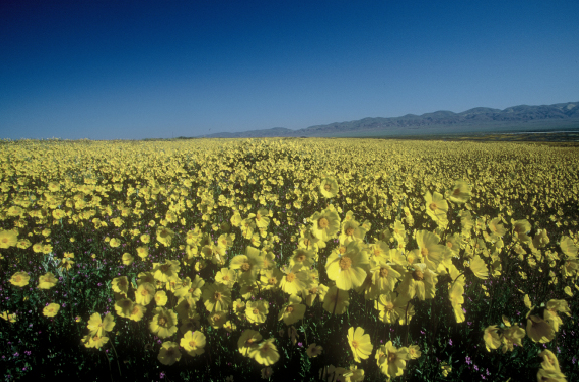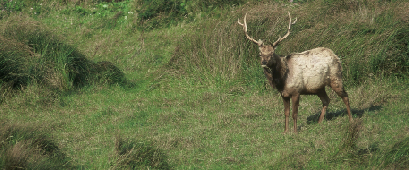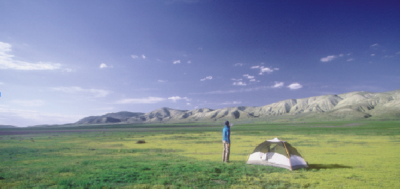Between the Mountains, the Carrizo Plain Beckons
Story by Chuck Graham
At dawn I lit out on a lonely trail leading to Painted Rock. The natural sandstone cathedral is still a vital meeting and ceremonial venue for Native American tribes like the Chumash and Yokuts on the Carrizo Plain National Monument. As I entered Painted Rock, shadows retreated across the sweeping valley floor as the sun rose above the Temblor Mountains to the east.
Remnants of elaborate rock art still clung to the canvas of gritty sandstone. As I gazed at all the remaining detailed rock art, there was a flash of feathers flying over me, exiting one of the many lofty alcoves inside the massive rock outcropping. The east wall was cloaked in multi-colored lichen. Reds, oranges, yellows and browns decorated the broad sandstone slab, and perched on its face were two barn owls soaking in the morning sun. Their feathers blended in perfectly where they were perched, overlooking the broad expanse of grasslands.
As it grew warmer, I watched from the inside of Painted Rock a small herd of pronghorn antelope rising from where they were bedded down the night before. As they rose and shook off the morning dew from their matted coats, they immediately began to graze the grasslands moving east to west, wide open spaces abounding across the Carrizo Plain.

A carpet of tickseed coreopsis blankets the Carrizo Plain National Monument from Soda Lake to the Temblor Mountains
Coming Together
Back in 1988, The Nature Conservancy (TNC) partnered up with the U.S. Bureau of Land Management (BLM) and the California Department of Fish and Wildlife to aquire, manage and protect this breathtaking expanse of land. The initial parcel was 82,000 acres, but today it is 250,000 acres.
On January 12, 2001, the largest single native grasslands remaining in California was deemed a National Monument by former President Bill Clinton, thus protecting the Carrizo Plain from any oil exploration and further habitat destruction.
The panoramic landscape is the largest protected habitat along the Pacific Flyway, making it a birder’s paradise. Besides the expansive grassland habitat, it also includes woodland habitats, mountain ranges reaching over 5,000 feet, Soda Lake, the largest natural alkali lake in the state, and surrounding vernal pools. The Carrizo Plain has more endangered species than anywhere else in California.
“It is one of the primary core recovery areas for a whole suite of endangered species,” said Bob Stafford, a senior environmental scientist for California Fish and Wildlife (CDFW). “It also has one of the larger Tule elk herds in the state.”
California’s Serengeti
With my high-powered optics, I scanned across the Carrizo Plain from the foothills of the Caliente Range in search of ungulates such as Tule elk and pronghorn antelope. It’s not until late morning when I spot a single file procession of Tule elk, maybe 40 animals, moving gradually west of me. A mixture of cows and calves followed closely together across a vibrant field of wildflowers, where a carpet of tidy tips and owl’s clover brightened the plain.
California’s Central Valley was once teeming with animals like Tule elk and pronghorn antelope. Loss of habitat, disease from livestock and overhunting took its toll on massive herds of ungulates leaving places like the Carrizo Plain void of such wildlife. But in the late 1980s, the then-CDFW embarked on changing a lifeless landscape. Herds of Tule elk were transplanted to the Carrizo Plain in 1988. Pronghorn Antelope were brought back to the plain in 1990.
Yet the two species’ populations are heading in divergent paths. Tule elk, being generalist feeders, have been able to adapt to perpetual drought conditions and are able to sustain themselves on dry grasses. Pronghorn antelope, on the other hand, are specialists requiring flat, wide open spaces while foraging for forbs. A survey performed by the U.S. Geological Survey in November, 2013 concluded of the 42 different plant species consumed by pronghorn, 26 of those species were forbs. The other plants consumed were species of grasses and shrubs.
“We have seen some dramatic fluctuations in most populations depending on weather conditions,” continued Stafford, who has worked on the Carrizo Plain for 19 years. “Long-term trends would be an increase in Tule elk numbers and a decrease in pronghorn numbers.”

Tule elk on the Carrizo Plain are one of the fastest growing herds in California.
According to the most recent aerial surveys, Stafford said there are somewhere between 350 to 400 Tule elk and 60 to 70 pronghorn in the greater Carrizo Plain ecosystem and surrounding ranchlands. Tule elk were expected to continue their stabilizing trend because they’re able to occupy and do well in a greater variety of habitat conditions — whether it’s the grasslands or the surrounding mountain ranges. Pronghorn, however, are on the cusp of sustainability, but the CDFW is in the process of curbing this trend.
Water troughs have been part of the Carrizo Plain for some time, but additional troughs have been added to aid declining pronghorn numbers. Stafford said the troughs are hooked up to water tanks in the existing system. They’ve also been providing supplemental food sources. However, their numbers are so low, any negative fluctuations in their habitat could prove detrimental.
“Pronghorn numbers have dropped to levels where any negative environmental factors will have serious impacts on the herds,” he said. “Moving more animals into the area without addressing the reasons for their decline would not be considered an option.”
If pronghorn numbers continue to decline and reach a certain point, a wide variety of environmental events can keep pronghorn numbers low.
“Summer and fall forage are one of the primary factors,” he said. “Fall forage plants (morning glory) commonly grow in late summer in cultivated fields. While taking these lands out of cultivation is a definite positive for most of the Carrizo species, it decreases habitat value for pronghorn.”
Although pronghorn numbers remain low, Stafford did say that the 2016 survey revealed their populations did not decline any further.
Survey Says
I’ve been coming out to the Carrizo Plain for more than 12 years. Drawn by its epic, wide open landscapes and perpetual solitude, the Carrizo Plain has been a great escape to experience a piece of old California. It’s also a great place to see wildlife if you’re willing to drive slowly on its dirt roads, hike cross country and simply sit patiently and watch for some kind of movement.
Wildlife like the San Joaquin kit fox, badger, desert cottontail rabbit, jackrabbit, antelope ground squirrel, coyote, blunt-nose leopard lizard and roughly 200 bird species blend in extremely well within the arid landscape.
Once, about 300 feet off the road between the Selby and KCL Campgrounds, my wife and I came across a pair of kit foxes sunning themselves out in the open near one of their den sites. They had flattened themselves against the ground. When I stopped my truck the female dove into their den, but the male didn’t budge. It allowed me to belly crawl to within 30 feet of it, and at one point it became so relaxed that it fell asleep. It was a good intimate look at one of the Carrizo Plain’s most elusive residents.
“Kit fox populations have definitely been down,” said Stafford of the Carrizo Plain population. “We do surveys (of kit foxes) pretty much year-round, but kit fox numbers did increase in 2016 to roughly pre-drought levels.”
Spotlight surveys typically take place in March, June, September and December as long as the weather holds up. Stafford said surveys cover roughly two separate 35 mile routes. He’s been performing these surveys since 2000. Like most wildlife on the Carrizo Plain, kit fox populations fluctuate according to the weather. Since 2000, Stafford and his team have counted 2,471 kit foxes covering 109 kilometers of dirt roads in the Carrizo Plain. The high count was in the summer of 2005 with 1,788 kit foxes. The low count was 65 kit foxes in the fall of 2014.
“Kit foxes are the primary focus,” he continued, “but we also count all carnivores and try to get an estimate of prey species. We’ve even seen kit foxes follow badgers as they dig up small mammals.”
The last significant rainfall on the Carrizo Plain was the winter of 2009-2010. Since then, there’s been a reduction in small prey populations like antelope ground squirrels and giant kangaroo rats, thus kit foxes have been experiencing some lean times on the plain. That was until 2016, when the Carrizo Plain received just enough rain and surveys saw an increase in most species.
“Giant kangaroo rats are basically the key species in the entire Carrizo web,” he said. “As they go, so do a lot of the other endangered species.”
There are many predators in the Carrizo Plain that not only rely on giant kangaroo rats as a food source, but also for their burrow sites. Everything from kit foxes, burrowing owls and badgers to snakes and long-tailed weasels locate, take over and modify giant kangaroo rat burrow sites.
“The burrows are also used by blunt-nose leopard lizards,” said Stafford, “and California jewel flower is often associated with the burrow systems.”
The largest of the 21 species of kangaroo rats, giant kangaroo rats are native to the San Joaquin Valley, and are arguably the most important animal on the Carrizo Plain. Until 2016, giant kangaroo rats were kind of a big unknown on the Carrizo Plain, because of the continuing extreme drought conditions. The tiny, nocturnal rodents with the big feet, eyes and long tails work like little lawnmowers on the grasslands — virtually mowing down huge swaths of grasses surrounding their burrowing sites. Stafford and his team locate and count the giant kangaroo rats by flying over their sites.
Even with degraded habitat this keystone species can thrive in what’s remaining, with an average of 69 individuals per nearly 2.5 acres. These busy tunnel diggers can transform huge swaths of habitat by building extensive burrow mounds up to 30 feet in diameter and three feet underground.
“They mow down the area around their burrows so we can fly transects over the area to map the areas they mow down,” explained Stafford. “Problem is, if we don’t get any growth they have nothing to mow and we have nothing to survey.”
Fortunately, 2016 was a different story. Like kit foxes, Stafford said giant kangaroo rats expanded to pre-drought levels and their populations had increased due to reproduction over the last year.
Grassland Canvas
In 2014 I saw and photographed one wildflower on the Carrizo Plain. The state flower, a lonely California poppy, appeared out of place on an otherwise uninspiring landscape on the way up to an empty Selby Campground.
The last great wildflower season was the spring of 2010, when the 50-mile-long Carrizo Plain transformed into a palette of pinks and reds, yellows, oranges, purples and blues. It appeared as if someone had come to the plain, taken a giant paintbrush and splashed bright colors across the grasslands, the Temblor and Caliente Ranges. The bush lupine was so fragrant it was thick in the air. Massive fields of tickseed coreopsis swept across from the east side of Soda Lake almost to the base of the Temblors on the Elkhorn Plain. Massive fields of tidy tips were so dense that when I laid down in them they shaded me from the sun. From Soda Lake Road, out near one of the old ranch sites closer to the Elkhorn Plain, appeared to be a lake that actually turned out to be a broad, deep bluish purple field of phacelia.
The bloom of 2016 was not as impressive as 2010, but it was noteworthy. There were several eye-popping clusters of desert candles and blazing stars where dense mud flos filled seasonal arroyos. It made for an interesting contrast of colorful blooms bursting free out of cracked mud.

Camping amid goldfields on the Elkhorn Plain in the southeast corner of the Carrizo Plain National Monument.
“There are a couple of endangered plants on the Carrizo Plain (California jewel flower in particular),” said Stafford. “However, the general long term trend has been an increase in native plants compared to the 1980s, since large portions of Carrizo were still in cultivation at that time. It is a mixed bag for native vegetation. Giant kangaroo rats, Tule elk and pronghorn have no problem consuming nonnative plants.”
I made five trips out to the Carrizo Plain in 2016. As spectacular as a wildflower bloom is, they’re even more fleeting, gone before you know it, so I squeezed in as many days as I could before that bloom withered away and was a distant memory.
During one of those trips I drove out onto the Elkhorn Plain in the southeast corner of the national monument. I pitched my tent in a splash of goldfields and vibrant phacelia against the stark contrast of arid badlands. There was a pair of huge pronghorn antelope bulls loping beneath the base of the Temblor Range. It wasn’t long before North America’s fastest land mammal bounded across the Elkhorn Plain, vanishing in the cleft of the badlands.

Leave A Comment